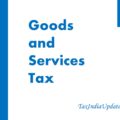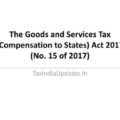Introduction
The taxable event under GST is supply of goods or services or both. GST will be payable on every supply of goods or services or both unless otherwise exempted. The rates at which GST is payable for individual goods or services or both is also separately -notified. Classification of supply (whether as goods or services, the category of goods and services) is essential to charge applicable rate of GST on the particular supply. The application of rates will pose no problem if the supply is of individual goods or services which is clearly identifiable and the goods or services are subject to a particular rate of tax.
But not all supplies will be such simple and clearly identifiable supplies. Some of the supplies will be a combination of goods or combination of services or combination of goods and services both. Each individual component in a given supply may attract different rate of tax. The rate of tax to be levied on such supplies may pose a problem in respect of classification of such supplies. It is for this reason, that the GST Law identifies composite supplies and mixed supplies and provides certainty in respect of tax treatment under GST for such supplies.
Composite Supply under GST
Under GST, a composite supply would mean a supply made by a taxable person to a recipient consisting of two or more taxable supplies of goods or services or both, or any combination thereof, which are naturally bundled and supplied in conjunction with each other in the ordinary course of business, one of which is a principal supply;
Illustration: Where goods are packed and transported with insurance, the supply of goods, packing materials, transport and insurance is a composite supply and supply of goods is a principal supply.
A works contracts and restaurant services are classic examples of composite supplies, however the GST Act identifies both as supply of services and chargeable to specific rate of tax mentioned against such services. (Works contract and restaurant)
In respect of composite supplies (other than the two categories mentioned above), the need to determine the supply as a composite one, will arise, so as to determine the appropriate classification. It will be necessary to determine as to whether a particular supply is naturally bundled in the ordinary course of business and what constitutes principal supply in such composite supplies.
The concept of composite supply under GST is identical to the concept of naturally bundled services prevailing
in the existing service tax regime. This concept has been explained in the Education Guide issued by CBEC in the year 2012 as under –
“‘Bundled service’ means a bundle of provision of various services wherein an element of provision of one service is combined with an element or elements of provision of any other service or services. An example of ‘bundled service’ would be air transport services provided by airlines wherein an element of transportation of passenger by air is combined with an element of provision of catering service on board. Each service involves differential treatment as a manner of determination of value of two services for the purpose of charging service tax is different.
The rule is – ‘If various elements of a bundled service are naturally bundled in the ordinary course of business, it shall be treated as provision of a single service which gives such bundle its essential character’
Illustrations –
· A hotel provides a 4-D/3-N package with the facility of breakfast. This is a natural bundling of services in the ordinary course of business. The service of hotel accommodation gives the bundle the essential character and would, therefore, be treated as service of providing hotel accommodation.
A 5 star hotel is booked for a conference of 100 delegates on a lump sum package with the following facilities:
- Accommodation for the delegates
- Breakfast for the delegates,
- Tea and coffee during conference
- Access to fitness room for the delegates
- Availability of conference room
- Business centre
As is evident a bouquet of services is being provided, many of them chargeable to different effective rates of tax. None of the individual constituents are able to provide the essential character of the service. However, if the service is described as a conventional service it is able to capture the entire essence of the package. Thus, the service may be judged as convention service and chargeable to full rate. However, it will be fully justifiable for the hotel to charge individually for the services as long as there is no attempt to offload the value of one service on to another service that is chargeable at a concessional rate.
Whether services are bundled in the ordinary course of business would depend upon the normal or frequent practices followed in the area of business to which services relate. Such normal and frequent practices adopted in a business can be ascertained from several indicators some of which are listed below –
· The perception of the consumer or the service receiver. If large number of service receivers of such bundle of services reasonably expect such services to be provided
as a package, then such a package could be treated as naturally bundled in the ordinary course of business.
· Majority of service providers in a particular area of business provide similar bundle of services. For example, bundle of catering on board and transport by air is a bundle offered by a majority of airlines.
· The nature of the various services in a bundle of services will also help in determining whether the services are bundled in the ordinary course of business. If the nature of services is such that one of the services is the main service and the other services combined with such service are in the nature of incidental or ancillary services which help in better enjoyment of a main service. For example, service of stay in a hotel is often combined with a service or laundering of 3-4 items of clothing free of cost per day. Such service is an ancillary service to the provision of hotel accommodation and the resultant package would be treated as services naturally bundled in the ordinary course of business.
· Other illustrative indicators, not determinative but indicative of bundling of services in ordinary course of business are –
· There is a single price or the customer pays the same amount, no matter how much of the package they actually receive or use.
The elements are normally advertised as a package.
· The different elements are not available separately.
· The different elements are integral to one overall supply – if one or more is removed, the nature of the supply would be affected.
No straight jacket formula can be laid down to determine whether a service is naturally bundled in the ordinary course of business. Each case has to be individually examined in the backdrop of several factors some of which are outlined above.”
The above principles explained in the light of what constitutes a naturally bundled service can be gainfully adopted to determine whether a particular supply constitutes a composite supply under GST and if so what constitutes the principal supply so as to determine the right classification and rate of tax of such composite supply.
Mixed Supply
Under GST, a mixed supply means two or more individual supplies of goods or services, or any combination thereof, made in conjunction with each other by a taxable person for a single price where such supply does not constitute a composite supply;
Illustration: A supply of a package consisting of canned foods, sweets, chocolates, cakes, dry fruits, aerated drinks and fruit juices when supplied for a single, price is a mixed supply. Each of these items can be supplied separately and is not dependent on any other. It shall not be a mixed supply if these items are supplied separately.
In order to identify if the particular supply is a Mixed Supply, the first requisite is to rule out that the supply is a composite supply. A supply can be a mixed supply only if it is not a composite supply. As a corollary it can be said that if the transaction consists of supplies not naturally bundled in the ordinary course of business then it would be a Mixed Supply. Once the amenability of the transaction as a composite supply is ruled out, it would be a mixed supply, classified in terms of a supply of goods or services attracting highest rate of tax.
The following illustration given in the Education Guide of CBEC referred to above can be a pointer towards a mixed supply of services: –
“A house is given on rent one floor of which is to be used as residence and the other for housing a printing press. Such renting for two different purposes is not naturally bundled in the ordinary course of business. Therefore, if a single rent deed is executed it will be treated as a service comprising entirely of such service which attracts highest liability of service tax. In this case renting for use as residence is a negative list service while renting for non-residence use is chargeable to tax. Since the latter category attracts highest liability of service tax amongst the two services bundled together, the entire bundle would be treated as renting of commercial property.”
Determination of tax liability of tax liability of Composite and Mixed Supplies
The tax liability on a composite or a mixed supply shall be determined in the following manner, namely: —
a) acomposite supply comprising two or more supplies, one of which is a principal supply, shall be treated as a supply of such principal supply; and
b) amixed supply comprising two or more supplies shall be treated as a supply of that particular supply which attracts the highest rate of tax.
Time of supply in case of Composite supply
If the composite supply involves supply of services as principal supply, such composite supply would qualify as supply of services and accordingly the provisions relating to time of supply of services would be applicable. Alternatively, if composite supply involves supply of goods as principal supply, such composite supply would qualify as supply of goods and accordingly, the provisions relating to time of supply of goods would be applicable.
Time of supply in case of mixed supplies
The mixed supply, if involves supply of a service liable to tax at higher rates than any other constituent supplies, such mixed supply would qualify as supply of services and accordingly the provisions relating to time of supply of services would be applicable. Alternatively, the mixed supply, if involves supply of goods liable to tax at higher rates than any other constituent supplies, such mixed supply would qualify as supply of goods and accordingly the provisions relating to time of supply of services would be applicable.
Certain clarifications on composite and mixed supply given by CBEC
The printing industry in India in particular faces a dilemma in determining whether the nature of supply provided is that of goods or services and whether in case certain contracts involve both supply of goods and services, whether the same would constitute a supply of goods or services or if it would be a composite supply and in case it is, then what would constitute the principal supply. It is to be noted that in case of composite supplies, taxability is determined by the principal supply. To address concerns of the printing industry, CBEC has come out with Circular no.11/11/2017- GST dated 20.10.2017, where in it is clarified as under:
“It is clarified that supply of books, pamphlets, brochures, envelopes, annual reports, leaflets, cartons, boxes etc. printed with logo, design, name, address or other contents supplied by the recipient of such printed goods, are composite supplies and the question, whether such supplies constitute supply of goods or services would be determined on the basis of what constitutes the principal supply.
In the case of printing of books, pamphlets, brochures, annual reports, and the like, where only content is supplied by the publisher or the person who owns the usage rights to the intangible inputs while the physical inputs including paper used for printing belong to the printer, supply of printing [of the content supplied by the recipient of supply] is the principal supply and therefore such supplies would constitute supply of service falling under heading 9989 of the scheme of classification of services.
In case of supply of printed envelopes, letter cards, printed boxes, tissues, napkins, wall paper etc. falling under Chapter 48 or 49, printed with design, logo etc. supplied by the recipient of goods but made using physical inputs including paper belonging to the printer, predominant supply is that of goods and the supply of printing of the content [supplied by the recipient of supply] is ancillary to the principal supply of goods and therefore such supplies would constitute supply of goods falling under respective headings of Chapter 48 or 49 of the Customs Tariff.





